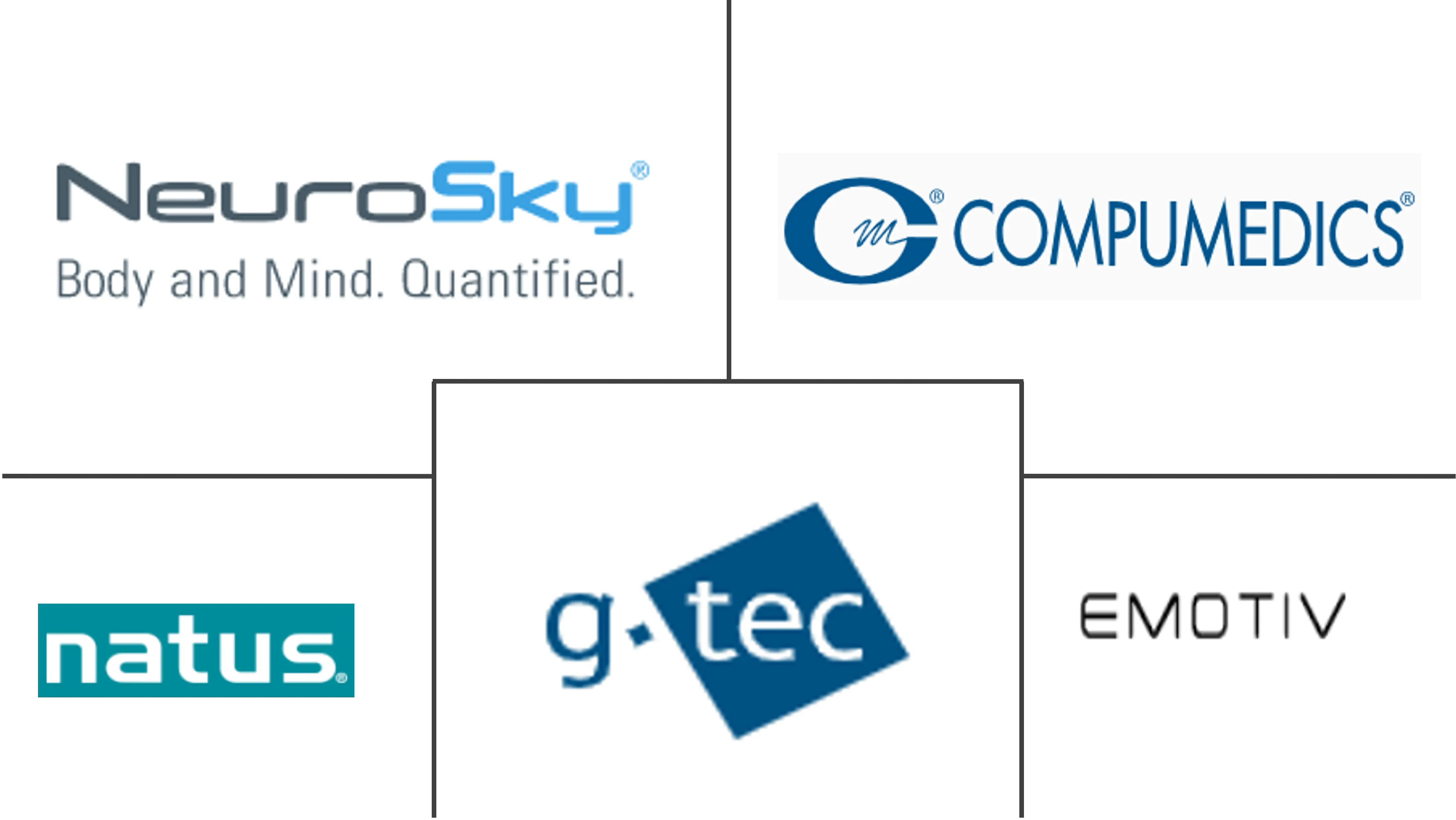Brain-computer Interface Market Size and Share
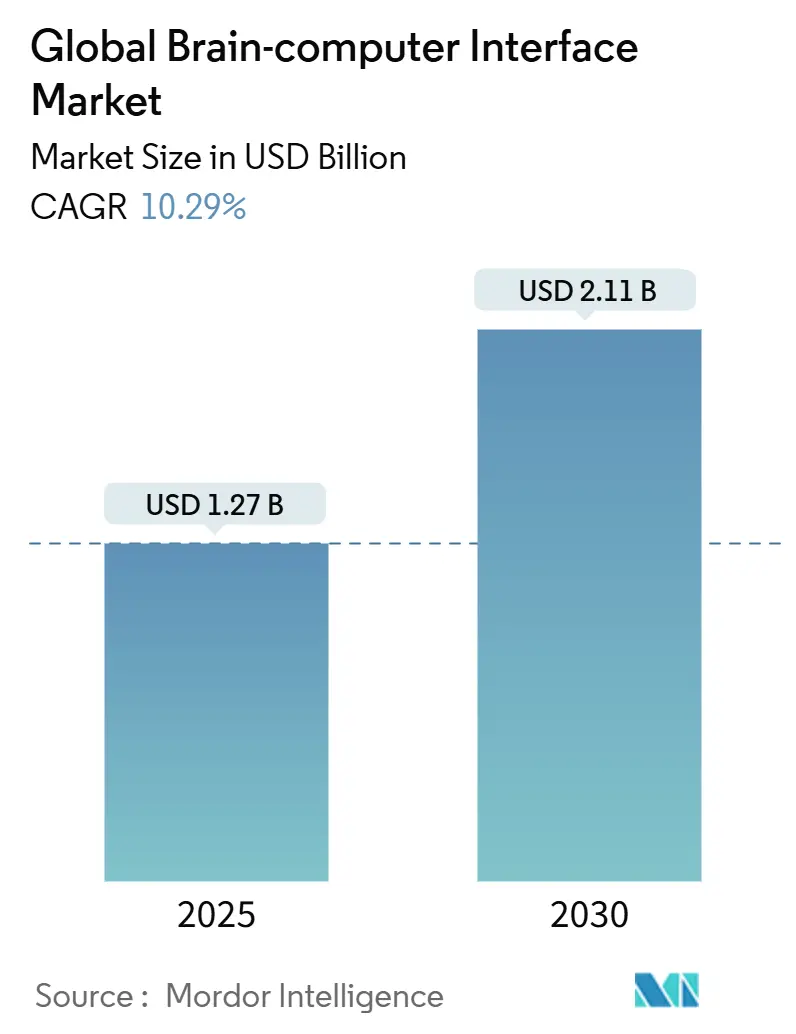
Brain-computer Interface Market Analysis by Mordor Intelligence
The Global Brain-computer Interface Market size is estimated at USD 1.27 billion in 2025, and is expected to reach USD 2.11 billion by 2030, at a CAGR of 10.29% during the forecast period (2025-2030).
Capital inflows, maturing hardware platforms, and the pairing of neural decoding with advanced artificial intelligence are the primary forces behind this expansion. Venture funding continues to shorten commercialization timelines, hospitals accelerate early adoption of implantable solutions, and consumer-facing headsets extend the reach of the Brain-Computer Interface market into gaming, well-being, and human–machine symbiosis. Hybrid signal architectures and software-defined features further support product differentiation, while government-funded clinical trials push forward standards for safety and ethics [1]Source: National Institutes of Health, “Brain-computer interface helps paralyzed man speak,” nih.gov . On the demand side, rising prevalence of neuro-degenerative disorders and heightened expectations for assistive communication tools keep clinical users at the core of revenue generation.
Key Report Takeaways
- By component, non-invasive hardware held 76.50% of the Brain-Computer Interface market share in 2024; software and algorithms post the fastest 12.10% CAGR through 2030.
- By interface type, motor/output BCIs led with 50.90% revenue share in 2024; hybrid systems advance at a 13.56% CAGR to 2030.
- By application, neuro-prosthetics captured 49.56% of the Brain-Computer Interface market size in 2024, while communication and control applications rise at 12.96% CAGR.
- By end-user, hospitals and clinics commanded 45.50% share of the Brain-Computer Interface market in 2024; research and academic institutes record the highest projected 12.45% CAGR.
- By geography, North America contributed 48.54% to 2024 revenues; Asia-Pacific is set to register a 12.56% CAGR through 2030.
Global Brain-computer Interface Market Trends and Insights
Drivers Impact Analysis
| Driver | (~) % Impact on CAGR Forecast | Geographic Relevance | Peak Impact |
|---|---|---|---|
| Surging demand for assistive communication technologies for ALS and severe paralysis patients | ~+2.3 | Global, with emphasis on North America and Europe | Medium term (~ 3-4 yrs) |
| Rapid adoption of EEG-based wearable headsets by eSports and gaming companies | ~+1.5 | North America, Europe, East Asia | Short term (≤ 2 yrs) |
| High VC funding in neuro-tech hubs (Silicon Valley, Lausanne, Vienna) accelerating product commercialization timelines | ~+2.1 | North America (Silicon Valley), Europe (Lausanne, Vienna) | Short term (≤ 2 yrs) |
| Rising R&D Activities by Government to Improve the Brain-computer Interface Technology | ~+1.8 | Global, with emphasis on US, UK, China | Medium term (~ 3-4 yrs) |
| Rising prevalence of neuro-degenerative disorders in ageing populations of Japan and EU spurring clinical trials | ~+1.4 | Japan, EU, North America | Long term (≥ 5 yrs |
| Source: Mordor Intelligence | |||
Surging demand for assistive communication technologies
National Institutes of Health–backed research restored intelligible speech for a paralyzed patient with 99% word-level accuracy [2]. Synchron subsequently paired its Stentrode implant with a generative-AI model, enabling hands-free texting for additional users. Hospitals report shorter caregiver cycles and higher patient-autonomy scores, expanding the clinical addressable pool beyond ALS to traumatic spinal-cord injury and brain-stem stroke (user data). Private insurers in the United States have begun reviewing early reimbursement cases for speech-decoding implants, indicating growing payer recognition of durable quality-of-life gains. European teaching hospitals now integrate language-model–enhanced BCIs in multidisciplinary neuro-rehabilitation programs, reinforcing mid-term adoption across the region.
Rapid adoption of EEG-based wearable headsets
Gaming studios, e-sports organizers, and consumer-wellness brands integrate dry-electrode headsets into interactive titles, fitness programs, and meditation platforms. Streamers demonstrate full-gameplay control with neural inputs, while competitive leagues trial concentration and emotional-state data for coaching. These deployments sharpen algorithms for low-latency signal extraction, accelerate miniaturization, and educate non-medical audiences on everyday benefits of brain–computer interaction. As shipments grow, economies of scale begin to lower unit costs, allowing vendors to bundle subscription-based analytics that deepen revenue per user.
High VC funding in neuro-tech hubs
Single-round investments surpassing USD 100 million enable rapid scale-up of clean-room electrode fabrication, animal studies, and early human trials. Capital clustering in Silicon Valley, Lausanne, and Vienna fuels a dense knowledge network that transfers best practices across start-ups, universities, and contract manufacturers. Portfolio diversification by cryptocurrency platforms and cloud-service providers signals cross-industry confidence in neural interface monetization. Investors demand accelerated regulatory filings, prompting firms to raise internal quality-assurance capabilities and shorten iteration cycles between prototype and pivotal trial.
Rising R&D activities by government
The United Kingdom’s National Health Service allocated GBP 69 million to precision-neurotechnology trials, including a GBP 6.5 million study evaluating ultrasound-based mood-enhancement BCIs. China’s Ministry of Industry and Information Technology listed brain-machine interfaces as a strategic priority and formed a national standard-setting committee. The U.S. Government Accountability Office meanwhile recommended policy frameworks to clarify data ownership and reimbursement pathway.
Restraints Impact Analysis
| Restraint | (~) % Impact on CAGR Forecast | Geographic Relevance | Peak Impact |
|---|---|---|---|
| Surgical risks and regulatory hurdles limiting adoption of implantable BCI systems | -1.9 | Global | Medium term (~ 3-4 yrs) |
| Data-privacy concerns over neural data collection | -1.2 | North America, Europe | Short term (≤ 2 yrs) |
| Signal accuracy challenges due to hair & scalp impedance in mass-market EEG devices | -1.0 | Global, with emphasis on consumer markets | Short term (≤ 2 yrs) |
| Scarcity of reimbursement codes for BCI-based rehabilitation therapies in public healthcare systems | -0.7 | Global, with emphasis on emerging markets | Medium term (~ 3-4 yrs) |
| Source: Mordor Intelligence | |||
Surgical risks and regulatory hurdles
Implantable systems deliver superior signal fidelity yet involve cranial or vascular procedures that few centers can perform. Reports of electrode migration, infection, and device retrieval create caution among clinicians and insurers. Regulatory agencies require lengthy safety monitoring, stretching time-to-market and inflating trial budgets. These obstacles confine early adoption to well-funded academic hospitals and wealthy self-pay patients, slowing broad penetration. Vendors respond by refining stent-like delivery tools and developing reversible implants but must still navigate multi-year approval pathways.
Data-privacy concerns over neural data collection
Legislators classify neuro-data as sensitive, forcing firms to maintain explicit consent, local storage options, and granular user controls. The absence of federal standards in the United States and differing regional rules in Europe add integration complexity for cloud services. Consumer groups warn that thought-pattern analytics could reveal intent, political views, or mental-health status, deterring mass-market uptake of wellness and gaming headsets. Companies are now embedding on-device encryption, edge-processing, and data-anonymization features to bolster trust, though compliance overhead increases development costs.
Segment Analysis
By Component: Non-invasive hardware retains leadership while software accelerates
Non-invasive headsets and electrode arrays generated 76.50% of 2024 revenue, underscoring their role as the entry point for many developers in the Brain-Computer Interface market. Product launches with dry electrodes and low-energy Bluetooth have reduced setup times and improved comfort, enabling everyday usage scenarios such as virtual-reality gaming and remote neurofeedback. Hospitals appreciate the avoidance of surgical risk, and consumer brands leverage lower regulatory hurdles to speed shelf placement. Price declines and improved signal-to-noise ratios continue to support double-digit growth despite intensifying competition.
Software and algorithm layers are expanding at a 12.10% CAGR, a pace that outstrips hardware because every incremental headset installation yields recurring licensing opportunities. Transformer-based decoders, transfer learning, and self-calibrating frameworks raise information-transfer rates by triple-digit percentages. These advances create an emergent SaaS sub-segment forecast to climb from USD 1.9 billion to USD 5.1 billion by 2030. Service providers follow close behind, offering cloud dashboards, electrode-maintenance contracts, and compliance audits to clinical buyers who lack in-house specialists. Together, these activities sustain a balanced revenue mix that shields vendors from pure hardware margin compression.

Note: Segment shares of all individual segments available upon report purchase
By Interface Type: Motor/output dominates while hybrid systems surge
Motor/output platforms accounted for 50.90% of spending in 2024, reflecting clinical priorities around restoring cursor control, wheelchair navigation, and prosthetic manipulation for paralysis patients. Successful demonstrations of non-invasive deep-learning decoders capable of sub-second response rates have widened appeal beyond the intensive-care unit. Consumer developers adapt these breakthroughs to gesture-less input for augmented-reality headsets and smart-home devices, reinforcing the segment’s maturity.
Hybrid architectures, combining EEG, electromyography, functional near-infrared spectroscopy, or focused ultrasound, are on course for 13.56% CAGR. They lift reliability by fusing multiple neural and peripheral signals, thereby compensating for artifacts that hamper single-modality systems. Experimental stroke-rehabilitation rigs illustrate the benefit: after two weeks of hybrid brain-muscle training, 83% of patients regained measurable hand function. As component costs fall, hybrid circuitry will migrate from the laboratory into modular consumer accessories.
By Application: Neuro-prosthetics steers revenue while communication accelerates
Neuro-prosthetics and motor-restoration solutions controlled 49.56% of 2024 sales, cementing their place at the heart of the Brain-Computer Interface market. Direct cortical stimulation now delivers tactile feedback on shape, pressure, and texture, enabling more intuitive use of robotic limbs. Regulatory bodies prioritize these life-changing therapies, granting breakthrough-device designations that streamline pivotal trials. Military-medicine grants and insurance pilots further reinforce a resilient reimbursement outlook for neuro-prosthetic indications.
Communication and control systems are the fastest-growing at a 12.96% CAGR as language-model integration trims keystrokes by more than half and multiplies transfer rates. Universal BCIs that bypass personalized calibration shrink training time, promising scalable deployment across rehabilitation centers and home-care settings. Early success stories of thought-based texting foster public awareness, while social-media coverage accelerates uptake among tech-savvy patients. Secondary applications in cognitive-state monitoring and digital wellness broaden market horizons.
By End-User: Hospitals dominate while research institutes accelerate
Hospitals and clinics governed 45.50% of 2024 turnover owing to their role in complex implant surgeries, long-term rehabilitation, and multidisciplinary care teams. Top academic centers run parallel programs in speech restoration, sensory feedback, and neuromodulation, allowing device manufacturers to access diverse patient cohorts under a single contractual framework. Collaborative bodies such as the Implantable Brain-Computer Interface Community align protocol standards, reducing administrative drag for trial sponsors.
Research and academic institutes will expand at 12.45% CAGR through 2030 as engineering, psychology, and computer-science faculties form cross-disciplinary labs, often with venture-capital participation. Grants targeting hybrid reality, adaptive learning, and precision mental-health interventions stimulate prototype production well ahead of commercial scale. These campuses double as talent pipelines for start-ups and large device companies, ensuring a steady flow of innovation into future product generations.
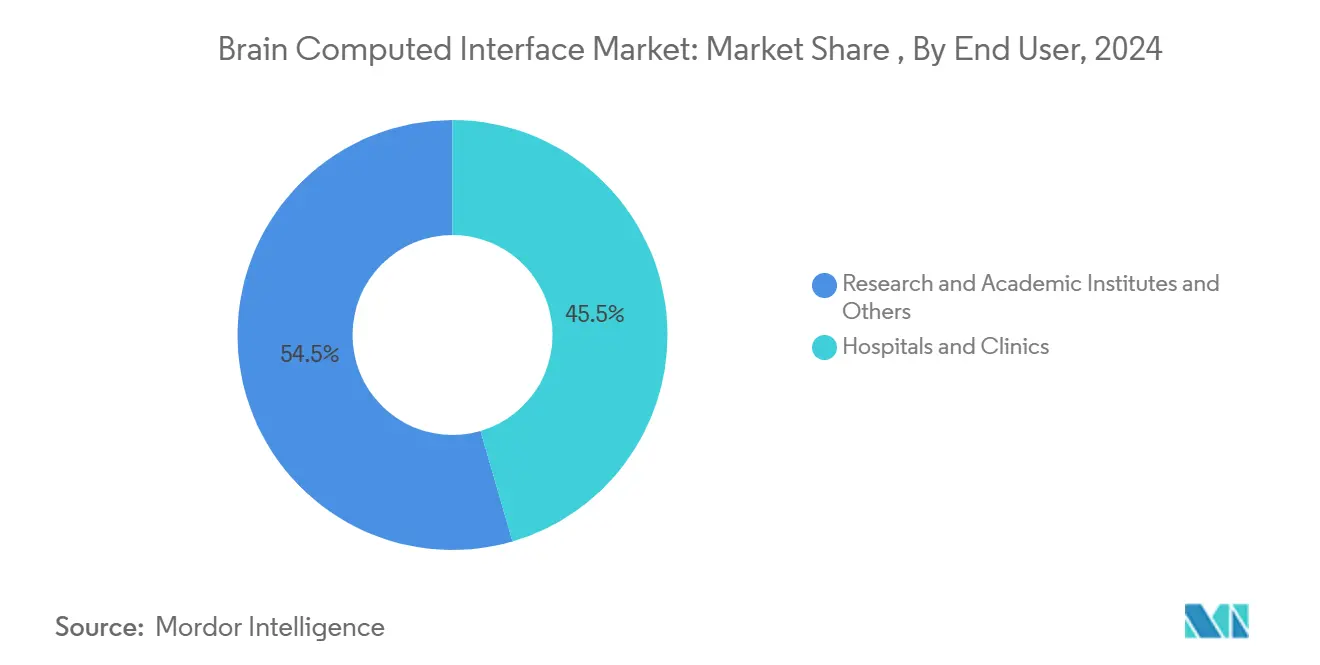
Note: Segment shares of all individual segments available upon report purchase
Geography Analysis
North America generated 48.54% of 2024 revenue and remains the anchor of the Brain-Computer Interface market. National Institutes of Health funding, deep venture pools, and specialized surgical teams underpin a continuous trial pipeline that spans speech decoding, bidirectional sensation, and neuromodulation for depression. The region benefits from early adopter health systems that integrate reimbursement studies into clinical workflows, accelerating payer acceptance. Privacy legislation is evolving rapidly, creating both compliance overhead and competitive advantage for firms that invest early in secure data architectures.
Asia-Pacific delivers the fastest 12.56% CAGR, propelled by Chinese government designation of brain-machine interfaces as a strategic industry. State grants encourage industrial-academic consortia, while new standards bodies tackle signal-acquisition protocols and ethical guidelines. Chinese start-ups have already demonstrated 71% accuracy in decoding Mandarin speech, underscoring regional momentum. Japan’s aging demographics add a structural demand driver for neuro-degenerative disease management, and South-Korean electronics majors contribute sensor miniaturization expertise.
Europe holds a significant share, with public-health systems funding mood-enhancement trials and stroke-recovery programs. The National Health Service’s GBP 6.5 million ultrasound-based BCI trial reinforces policy-level commitment to non-pharma approaches for mental-health conditions. The forthcoming EU AI Act classifies many AI-enabled medical devices as high-risk, compelling vendors to adopt rigorous cyber-security and performance-validation procedures that can become competitive differentiators in other regions. Smaller but growing markets in the Middle East, Africa, and South America invest in tele-rehabilitation and remote neuromonitoring, leveraging mobile connectivity and cross-border training partnerships.
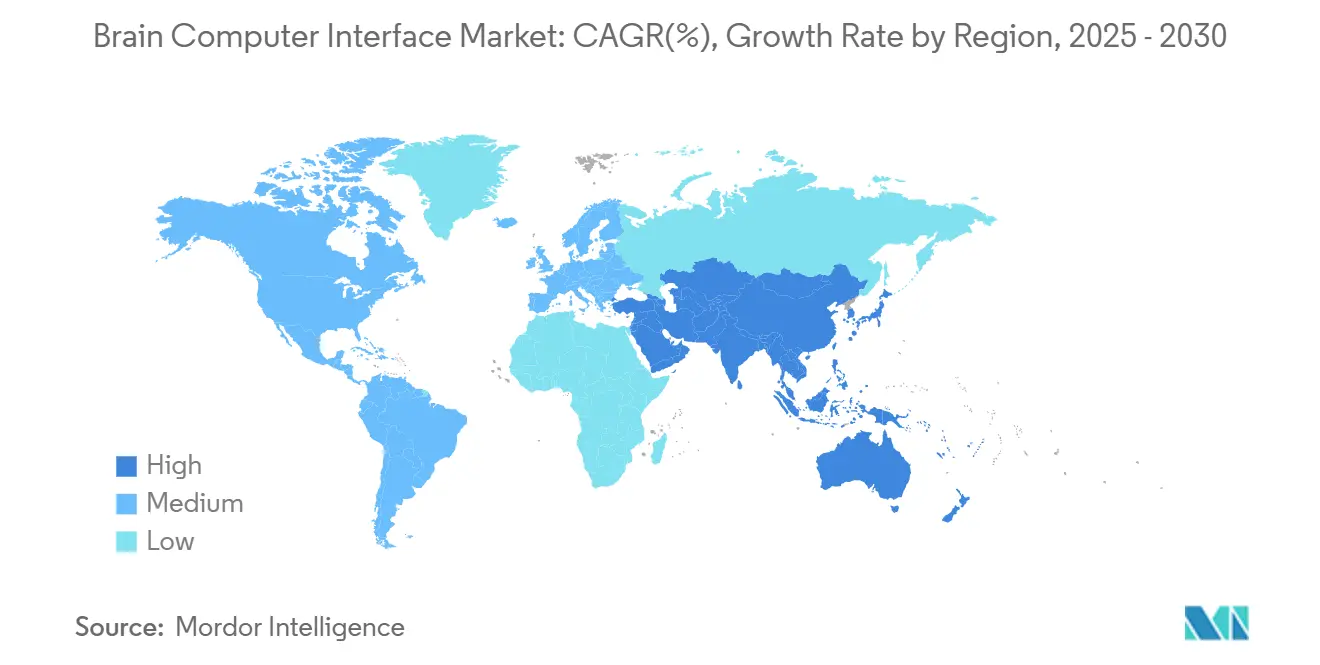
Competitive Landscape
Competitive Landscape
The Brain-Computer Interface market is moderately fragmented, with dynamic interplay among incumbent med-tech manufacturers, venture-backed specialists, and technology conglomerates. Leading invasive-device companies secure multi-year hospital contracts by showcasing clinical-trial outcomes that document restored speech, typing, and limb movement. Non-invasive consumer-focused vendors chase scale through mass production of affordable EEG headsets bundled with cloud analytics. Technology giants explore in-house silicon and software stacks that promise deeper ecosystem integration.
Strategic alliances redefine market boundaries. Cryptocurrency investors acquiring controlling stakes in implantable BCI firms inject liquidity and expand payment-system interoperability for future neuro-app stores. Cloud-service providers partner with headset makers to co-develop low-latency neural-processing interfaces that feed edge-computing platforms. Meanwhile, emergent disruptors scale wafer-thin cortical grids with electrode counts exceeding 1,000, opening paths to high-resolution sensory feedback.
White-space opportunities center on hybrid architectures that couple central-nervous, peripheral-nervous, and muscle signals into unified control schemas. Demand also rises for verticalized solutions targeting speech disorders, chronic pain, and mental-health applications. Vendors differentiate by embedding advanced encryption, local-inference engines, and clinician-friendly dashboards that simplify longitudinal monitoring. As value shifts toward software brilliance and service reliability, pricing power migrates away from pure hardware and toward full-stack neuro-platforms.
Brain-computer Interface Industry Leaders
-
Natus Medical Incorporated
-
Compumedics Ltd
-
EMOTIV
-
g.tec medical engineering GmbH
-
NeuroSky
- *Disclaimer: Major Players sorted in no particular order
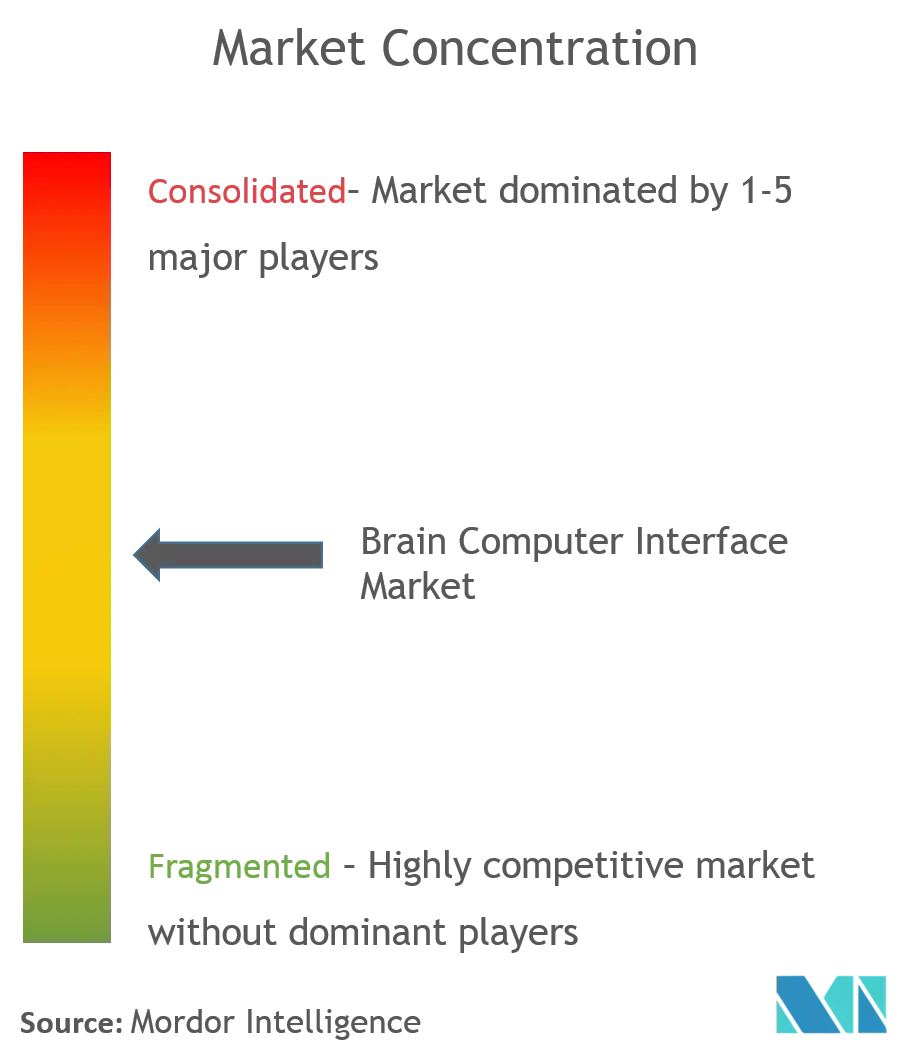
Recent Industry Developments
- January 2025: NeuroXess achieved 71% accuracy in decoding Chinese speech from a patient with its flexible 256-channel BCI, marking progress in language processing.
- January 2025: The UK National Health Service launched a GBP 6.5 million clinical trial using ultrasound-based BCIs for mood enhancement in depression, addiction, OCD, and epilepsy.
- January 2025: University of Chicago Medical Center researchers recreated tactile feedback in bionic hands through direct brain stimulation, enhancing prosthetic realism.
- July 2024: Synchron enabled patients with limited mobility to control Apple Vision Pro using implanted BCIs, broadening consumer-device compatibility.
Research Methodology Framework and Report Scope
Market Definitions and Key Coverage
Our study treats the brain-computer interface (BCI) market as the revenue generated worldwide from hardware, software, and supporting services that create a direct channel for translating measured neural activity into digital commands used to control external devices or software, whether by fully implanted electrodes, sub-dural grids, or wearable EEG headsets.
Scope exclusions include neuro-stimulation implants that do not decode signals (for example, deep-brain stimulators) and stand-alone AR/VR headsets without neural sensors, which are kept outside the size baseline.
Segmentation Overview
- By Component (Value)
- Hardware
- Invasive
- Non-invasive
- Others
- Software & Algorithms
- Services
- Hardware
- By Interface Type (Value)
- Motor / Output BCI
- Communication BCI
- Passive / Monitoring BCI
- Hybrid BCI
- By Application (Value)
- Neuro-prosthetics & Motor Restoration
- Communication & Control
- Others
- By End-User (Value)
- Hospitals & Clinics
- Research & Academic Institutes
- Others
- By Geography (Value)
- North America
- United States
- Canada
- Mexico
- Europe
- Germany
- United Kingdom
- France
- Italy
- Spain
- Rest of Europe
- Asia-Pacific
- China
- Japan
- India
- South Korea
- Australia
- Rest of Asia- Pacific
- Middle East and Africa
- GCC
- South Africa
- Rest of Middle East and Africa
- South America
- Brazil
- Argentina
- Rest of South America
- North America
Detailed Research Methodology and Data Validation
Primary Research
Mordor analysts interview neurosurgeons, rehabilitation clinicians, neuro-tech entrepreneurs, and component suppliers across North America, Europe, and Asia-Pacific. Dialogues clarify current average selling prices (ASPs) for non-invasive headsets, implantation backlogs, and expected reimbursement timelines, filling data gaps and confirming adoption assumptions before figures are locked.
Desk Research
We first pull foundational statistics from open datasets such as the U.S. National Institutes of Health clinical-trials registry, Eurostat disability prevalence tables, United Nations age-cohort forecasts, and export-import codes for neuro-diagnostic instruments. Patent analytics from Questel, device shipment clues from D&B Hoovers filings, and peer-reviewed journals on EEG signal fidelity complement these sources. Trade association white papers, like the IEEE Brain Initiative, and major press releases about FDA clearances deliver timely benchmarks. This list is illustrative; many additional references underpin the desk work.
Market-Sizing & Forecasting
A blended top-down model starts with incident pools of paralysis, epilepsy, and neuro-degenerative disorders, applies treatment-eligibility and BCI penetration ratios, and then multiplies by region-specific ASPs. Selective bottom-up cross-checks, such as annual headset shipments sampled from customs data and hospital procurement logs, calibrate totals. Key variables include: 1) global ALS prevalence, 2) number of FDA/CE-marked BCI approvals, 3) median headset ASP movement, 4) venture funding into BCI start-ups, 5) neuro-rehab bed capacity, and 6) non-invasive device clinical-trial success rates. Multivariate regression coupled with scenario analysis projects each driver to 2030; elasticities are refined through expert feedback, and missing bottom-up inputs are interpolated with regional proxy ratios.
Data Validation & Update Cycle
Outputs pass variance checks against historical device sales, currency effects, and public deals, after which a second analyst reviews anomalies. We refresh every twelve months or sooner if a material event, such as a new Class III approval, shifts the outlook; a final pre-publication sweep ensures clients receive the latest vetted numbers.
Why Mordor's Brain-computer Interface Baseline Commands Reliability
Published estimates often diverge because firms adopt wider neurotechnology scopes, embed differing ASP curves, or refresh tables on infrequent cycles.
Key gap drivers include: some publishers bundle neuromodulation stimulators alongside BCIs; others roll forward growth using uniform double-digit CAGRs without validating patient eligibility or price deflation; and a few assume immediate mass-market gaming uptake, inflating 2024 revenue far above evidenced shipment logs.
Benchmark comparison
| Market Size | Anonymized source | Primary gap driver |
|---|---|---|
| USD 1.27 B (2025) | Mordor Intelligence | |
| USD 2.44 B (2024) | Global Consultancy A | Includes non-BCI neuro-stim devices and applies one-step top-down value conversion |
| USD 2.62 B (2024) | Industry Publisher B | Assumes aggressive gaming uptake and flat ASPs, lacks bottom-up shipment validation |
In sum, our disciplined scope, dual-track modeling, and annual refresh cadence give decision-makers a balanced, transparent baseline that is firmly traceable to clinical eligibility pools, shipment realities, and verifiable price points, elements often missed or overstated elsewhere.
Key Questions Answered in the Report
Q1. What is the current value of the Brain-Computer Interface market?
A1. The Brain-Computer Interface market size reached USD 1.27 billion in 2025 and is projected to reach USD 2.11 billion by 2030 at a 10.29% CAGR.
Q2. Which component category leads the Brain-Computer Interface market? -computer Interface Market size?
A2. Non-invasive hardware dominates with 76.50% share in 2024, supported by user-friendly headsets and lower regulatory hurdles.
Q3. Which application is growing fastest?
A3. Communication and control applications post the highest 12.96% CAGR to 2030, driven by AI-enhanced speech-decoding BCIs.
Q4. Why is Asia-Pacific the fastest-growing region?
A4. Focused government funding, standard-setting initiatives, and breakthroughs such as Mandarin speech decoding propel Asia-Pacific toward a 12.56% CAGR.
Q5. What are major restraints facing the market?
A5. Surgical risk for implantable systems and evolving neural-data privacy regulations subtract 1.9 percentage points and 1.2 percentage points from forecast CAGR respectively, necessitating design and compliance innovation.
Q6. How concentrated is competition among key players?
A6. With the top five companies holding around 35% of revenue, competition is moderately fragmented, fostering continuous product differentiation and partnership activity.
Page last updated on:
